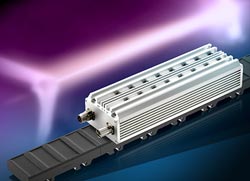Synchronous linear motor with magnet-free secondary section track

The innovative motor concept has all the advantages of direct drives such as high force density, high dynamic response, good control features and outstanding precision. As the secondary section track no longer has a permanent magnet, the 1FN6 is very inexpensive, especially in the case of long traversing distances.
The motor is therefore primarily used for applications in handling and linked axes or in highly dynamic and highly precise feeding axes of water-jet and laser-beam cutting machines. It is therefore an alternative to classic drive solutions with mechanical transmission elements such as gear racks or ball screws, as well as being an alternative to other types of motor such as asynchronous linear or reluctance motors. It is also ideal for applications in which a magnet-free secondary section track is essential.
In many applications in the machine tool area, long traversing distances have to be traveled quickly and precisely. Due to the costs of permanent magnets or in applications where it is difficult to protect the secondary section track against dirt, previous linear motor concepts could not be used or could only be used to a limited extent. The new 1FN8 linear motor is a synchronous linear motor developed by Siemens with a magnet-free secondary section track.
The motor has all the qualities of a synchronous direct drive such as high precision, outstanding dynamic response, the absence of a need for maintenance, a high force density and low energy losses. At the same time, the fact that no permanent magnets are used means is it easy to install, inexpensive and very robust. Applications can now be equipped with linear motors, whose traversing distances are very long or are open. Applications with very large air gaps due to the design can also be implemented with the 1FN6.
In the case of machine tools, the 1FN6 is especially suitable for applications where water-jet or laser-beam cutting is used. Particularly in the case of handling and linking applications with very long traversing distances and requirements for robust components, the linear motor is an alternative to classic linear drive systems with gear racks or belts. Thanks to its modular design, the motor can be adapted to meet the special requirements of an application. For the traversing distance, any number of secondary sections can be mounted next to each other. In addition, several primary sections can be operated on a secondary section track.
The first delivery stage of the 1FN6 linear motor is designed as a self-cooling version for the power range with a maximum force of 880 N to 7920 N. Linear motors of the 1FN6 series are designed for operation with the Sinamics S120 drive system. Configuration is carried out with the Tool Sizer, as is usual for the Sinamics drive family. Due to the connectors fitted to the front, a drive is created that is ready for use within a very short time thanks to its prefabricated power and signal cables.
Media Contact
More Information:
http://www.siemens.de/linearmotorenAll latest news from the category: Machine Engineering
Machine engineering is one of Germany’s key industries. The importance of this segment has led to the creation of new university degree programs in fields such as production and logistics, process engineering, vehicle/automotive engineering, production engineering and aerospace engineering among others.
innovations-report offers informative reports and articles covering technologies such as automation, motion, power train, energy, conveyor, plastics, lightweight construction, logistics/warehousing, measurement systems, machine tools and control engineering.
Newest articles

First-of-its-kind study uses remote sensing to monitor plastic debris in rivers and lakes
Remote sensing creates a cost-effective solution to monitoring plastic pollution. A first-of-its-kind study from researchers at the University of Minnesota Twin Cities shows how remote sensing can help monitor and…

Laser-based artificial neuron mimics nerve cell functions at lightning speed
With a processing speed a billion times faster than nature, chip-based laser neuron could help advance AI tasks such as pattern recognition and sequence prediction. Researchers have developed a laser-based…

Optimising the processing of plastic waste
Just one look in the yellow bin reveals a colourful jumble of different types of plastic. However, the purer and more uniform plastic waste is, the easier it is to…



